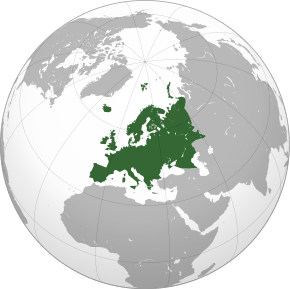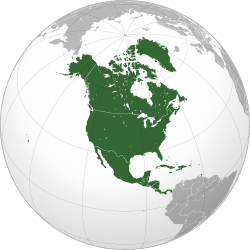List of supercontinents
This is a list of supercontinents.
Past
The list is written in reverse-chronological order ("stratolithic order"). Dates are given as the approximate beginning of the formation of the supercontinent; dates in parentheses are approximate date of the fully formed supercontinent. The Notes column provides the geologic time period of the fully formed supercontinent.
| Minor supercontinent |
| Major supercontinent |
| Name | Ga (Billions of years ago) |
Geologic time period[1] / Notes |
|---|---|---|
| Laurasia | ~0.253–~0.056 | Phanerozoic > Mesozoic[2] |
| Pangaea | ~0.335 (0.299[3]) –~0.173 | Phanerozoic > Paleozoic > Permian[4] |
| Euramerica | 0.433-0.056 | Was next to Gondwana. |
| Gondwana | ~0.62–~0.132 | Appeared in 550mya or the breakup of Pannotia. |
| Pannotia, also called Vendian | 0.62–~0.555 | Precambrian > Proterozoic > Neoproterozoic > Ediacaran[5] |
| Avalonia | 0.63–0.56 | |
| Protogondwana | 1.071–0.62 | |
| Protolaurasia | 1.071–0.592 | |
| Rodinia[6] | 1.071–~0.75 | Precambrian > Proterozoic > Neoproterozoic > Tonian |
| Cimmeria | 1.25–present | |
| Baltica | 1.8–present | |
| Laurentia | 1.816–present | |
| Columbia, also called Nuna | ~1.82–1.35 | Precambrian > Proterozoic > Mesoproterozoic > Calymmian |
| Nena | 1.95–0.592 | Formation is 1.95 bya. |
| Atlantica | 2.11–0.114 | Protracted tectonic magma plume rifting occurred 1.31 Ga. Final breakup occurred ~114 Ma. |
| India (continent) | 2.525–present | |
| Siberia (continent) | 2.695–present | |
| Sclavia | 2.665–2.33 | Kenorland is a "one-piece" alternative to Superia, Vaalbara, and Sclavia. |
| Kenorland | ~2.72–2.1 | Neoarchean sanukitoid cratons and new continental crust formed Kenorland. Protracted tectonic magma plume rifting occurred 2.48 to 2.4 Ga and this contributed to the Paleoproterozoic glacial events in 2.4 to 2.22 Ga. Final breakup occurred ~2.1 Ga. |
| Ur | ~3.0–2.803 | Classified as the earliest known landmass, Ur was a continent that existed three billion years ago. While probably not a supercontinent, one can argue that Ur was a supercontinent for its time as it was possibly the only continent on Earth, even if it was smaller than Australia is today. Still, an older rock formation now in Greenland dates back from Hadean times. |
| Congo (continent) (Protoafrica) | 3.6–present | This former continent thought to be parental to the São Francisco craton, Congo craton and the Central Africa. |
| Vaalbara | ~3.6–2.803 | Possibly the first supercontinent. |
| Superior Craton | 4.031–present | Existed when Vaalbara was formed. |
Present (now)
| Name | Millions of years (– = past, + = future) |
Notes |
|---|---|---|
| Afro-Eurasia | –5...+215 | |
| America | –15...+150 | |
| Eurasia | –253...+215 | If not considered a part of Afro-Eurasia or Afro-Eurasia-America. |
Future (speculative) (+)
| Name | Millions of years in the future | Notes |
|---|---|---|
| Novopangaea | 250 | This assumes closure of the Pacific Ocean, docking of Australia with East Asia, and northward motion of Antarctica. |
| Pangaea Proxima | 250 | Africa will meet North America by then. |
| Amasia | 250 | Everything moves north and meets near the Arctic Circle. |
| Aurica | 250 | Western Eurasia splits from Eastern Asia and moves west along with Africa, as Eastern Asia moves east along India and Australia. |
| Afro-Euraustralasia | 27–215 |
gollark: I mean, four is three more than one.
gollark: But nobody likes writing FOUR words.
gollark: It means "if and only if".
gollark: (iff is not a typo, before anyone does things)
gollark: Well, I would say that someone is a shallow person iff they do/say shallow things.
References
- Inc., Advanced Solutions International. "GSA Geologic Time Scale". www.geosociety.org. Retrieved 2018-09-02.
- "Tectonics of the Triassic Period". www.ucmp.berkeley.edu. Retrieved 2018-09-02.
- "The Permian Period". www.ucmp.berkeley.edu. Retrieved 2018-09-02.
- "The Permian Period". www.ucmp.berkeley.edu. Retrieved 2018-09-02.
- "The Ediacaran Period". www.ucmp.berkeley.edu. Retrieved 2018-09-02.
- "One of The Supercontinents Is Different from the Others (It's Rodinia)". Deep Carbon Observatory. 2017-12-14. Retrieved 2020-06-13.
External links
This article is issued from Wikipedia. The text is licensed under Creative Commons - Attribution - Sharealike. Additional terms may apply for the media files.
.svg.png)
.svg.png)
.svg.png)
.svg.png)


.svg.png)
_political.svg.png)
.svg.png)
.svg.png)
.svg.png)